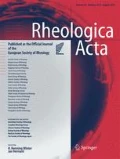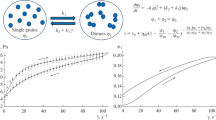Summary
A non-newtonian viscosity equation\(\eta _r = (1 - \tfrac{1}{2} \cdot \tilde k\phi )^{ - 2} \) whereφ is the volume concentration and\(\tilde k = (k_0 + k_\infty \dot \gamma _r^p )/(1 + \dot \gamma _r^p )\) is an intrinsic viscosity, function of a relative shear rate\(\dot \gamma _r = \dot \gamma /\dot \gamma _c , k_0 , k_\infty \) and\(\dot \gamma _c \) being structural parameters, has been proposed in a previous paper (1). From empirical grounds, the valuep = 1/2 holds for a large class of systems, like suspensions of rodand disc-shaped particles. In the high shear rate limit, aCasson law-type is recovered and discussed, especially the concentration dependence of the yield stress. However, the latter disappears in the low shear limit, and must be considered as a pseudo-yield stress. Good agreement is found in this low shear limit with some theoretical results ofBueche for polymers. More generally, the viscosity equation displays pseudo-plastic behaviour and fitting it on experimental data allows the determination of the structural parameters. Some examples (especially Red Blood Cell suspensions and Blood) are studied and support the model. Nevertheless, for spherical particle suspensions, the best fitting is reached forp = 1. Accurate values of particle diameters can be deduced from the structural parameter\(\dot \gamma _c \), in this case.
Zusammenfassung
In einer vorangegangenen Arbeit (1) wurde eine Viskositätsgleichung für eine nicht-newtonsche Flüssigkeit von der Form\(\eta _r = (1 - \tfrac{1}{2} \cdot \tilde k\phi )^{ - 2} \) vorgeschlagen, worinφ die Volumenkonzentration und\(\tilde k = (k_0 + k_\infty \dot \gamma _r^p )/(1 + \dot \gamma _r^p )\) eine Grenzviskosität bedeutet; die letztere stellt eine Funktion der relativen Schergeschwindigkeit\(\dot \gamma _r = \dot \gamma /\dot \gamma _c \) dar, die Konstantenk 0,k ∞ und\(\dot \gamma _c \) bezeichnen Strukturparameter. Empirisch wird gefunden, daß für eine große Klasse von Systemen, wie z. B. stäbchen- und scheibchenförmigen Teilchen,p = 1/2 gilt. In der Grenze hoher Schergeschwindigkeiten wird ein Verlauf gemäß einer Casson-Gleichung gefunden und diskutiert, insbesondere bezüglich der Konzentrationsabhängigkeit der Fließspannung. Allerdings verschwindet diese in der Grenze niedriger Schergeschwindigkeiten und muß daher als Pseudo-Fließspannung betrachtet werden. In diesem Grenzfall wird eine gute Übereinstimmung mit theoretischen Voraussagen vonBueche an Polymeren gefunden. Ganz allgemein beschreibt die obige Viskositätsgleichung ein pseudoplastisches Verhalten, und ihre Anpassung an experimentelle Werte erlaubt die Bestimmung der Strukturparameter. Einige Beispiele, insbesondere Suspensionen von roten Blutkörperchen und Blut, werden untersucht und bestätigen das Modell. Allerdings erhält man bei Suspensionen kugelförmiger Teilchen die beste Anpassung fürp = 1. In diesem Fall kann man mit Hilfe des Strukturparameters\(\dot \gamma _c \) genaue Werte der Teilchendurchmesser bestimmen.
Similar content being viewed by others
References
Quemada, D., Rheol. Acta17, 632 (1978).
Antonini, G., G. Guiffant, D. Quemada, J. de Chimie Physique7, 1123 (1974).
Antonini, G., G. Guiffant, D. Quemada, Biorheology,15, 111–117 (1978).
Dosne, A. M., C. Merville, L. Drouet, G. Antonini, G. Guiffant, D. Quemada, Microvascular Research14, 45 (1977).
Quemada, D., J. de Physique, Coll. C 1,37, 9 (1976).
Casson, N., in:C. C. Mills (ed.), Rheology of Disperse Systems, p. 84, Pergamon Press (London 1959).
Brooks, D. E., J. W. Goodwin, G. V. F. Seaman, Am. J. Appl. Physiol.28, 172 (1970).
Merrill, E. W., W. G. Margetts, G. R. Cokelet, A. Britten, E. W. Salzman, R. E. Pennel, M. Melin, in:A. L. Copley (ed.), Symp. on Biorheol., p. 601, Intersc. Publ. (New York 1964);Merril, E. W., J. W. Margetts, G. R. Cokelet, E. R. Gilliland, ibid., p. 135 (1964).
Bueche, F., J. Chem. Phys.22, 1570 (1974).
Tickner, E. G., A. M. Sacks, Circulation Res.25, 389 (1969).
Chien, S., Science168, 977 (1970).
Quemada, D., Comptes Rendus282 D, 1905 (1976).
Chien, S., S. Usami, R. J. Dellenback, C. A. Bryant, M. I. Gregersen, in:H. H. Hartet, A. L. Copley (eds.), Theor. and Clin. Hemorheol., p. 136, Springer-Verlag (Berlin 1971).
Burton, A. C., Physiology and Biophysics of the Circulation, Year Book Medic. Publ. (Chicago 1966).
Chien, S., S. A. Luse, K. M. Jan, L. H. Miller, S. Usami, L. H. Miller, H. Fremount, in:Ditzel, Lewis (eds.), Proc. 6th Europ. Conf. on Microcirculation, p. 29–34, Karger (Basel 1971).
Schmid-Schönbein, H., Blood Cells1, 285 (1975).
Schmid-Schönbein, H., G. Gallasch, E. Volger, H. J. Klose, Biorheology10, 213 (1973).
Schmid-Schönbein, H., R. Wells, in:H. H. Hartet, A. Copley (eds.), Theor. and Clin. Hemorheology, p. 348, Springer-Verlag (Berlin 1971).
Usami, S., S. Chien, M. I. Gregersen, in:H. H. Hartet, A. Copley (eds.), Theor. and Clin. Hemorheology, p. 266 (Berlin 1971).
Schmid-Schönbein, H., R. E. Wells, J. Goldstone, Biorheology7, 227 (1971).
Quemada, D., in:P. Aigrain, P. Nozières (eds.), De la Thermodynamique à la Géophysique, p. 191–207, CNRS (Paris 1978).
Brooks, D. E., J. W. Goodwin, G. V. F. Seaman, Biorheology11, 69–77 (1974).
Quemada, D., in:C. Klason, J. Kubat (eds.), Proc. VIIth Intern. Congr. on Rheology, p. 628 (Gothenburg 1976).
Papir, Y. S., I. M. Krieger, J. Colloid Interface Sci.34, 126 (1970).
Quemada, D., Rheol. Acta16, 82 (1977).
Author information
Authors and Affiliations
Additional information
With 5 figures and 3 tables
Rights and permissions
About this article
Cite this article
Quemada, D. Rheology of concentrated disperse systems III. General features of the proposed non-newtonian model. Comparison with experimental data. Rheol Acta 17, 643–653 (1978). https://doi.org/10.1007/BF01522037
Received:
Issue Date:
DOI: https://doi.org/10.1007/BF01522037




